This post may contain affiliate links at no additional cost to you. As an Amazon Associate I earn from qualifying purchases. Click to view our full disclosure.
What's inside
Have you ever walked into the gym and seen that one person who has big legs?
They must know all the correct exercises, intensity, and nutrition that makes them grow.
So, is there a secret formula to build monster thighs?
If you struggle with getting bigger legs, don’t be discouraged. You’re not alone here.
This exact problem is something I’ve had the privilege of helping many clients of mine break through in my years as a trainer.
Today, I will discuss how to get big legs, including diet, exercise, and more.
Let’s jump in.
Anatomy of the Legs
Related: 10 Best Leg Machines At The Gym
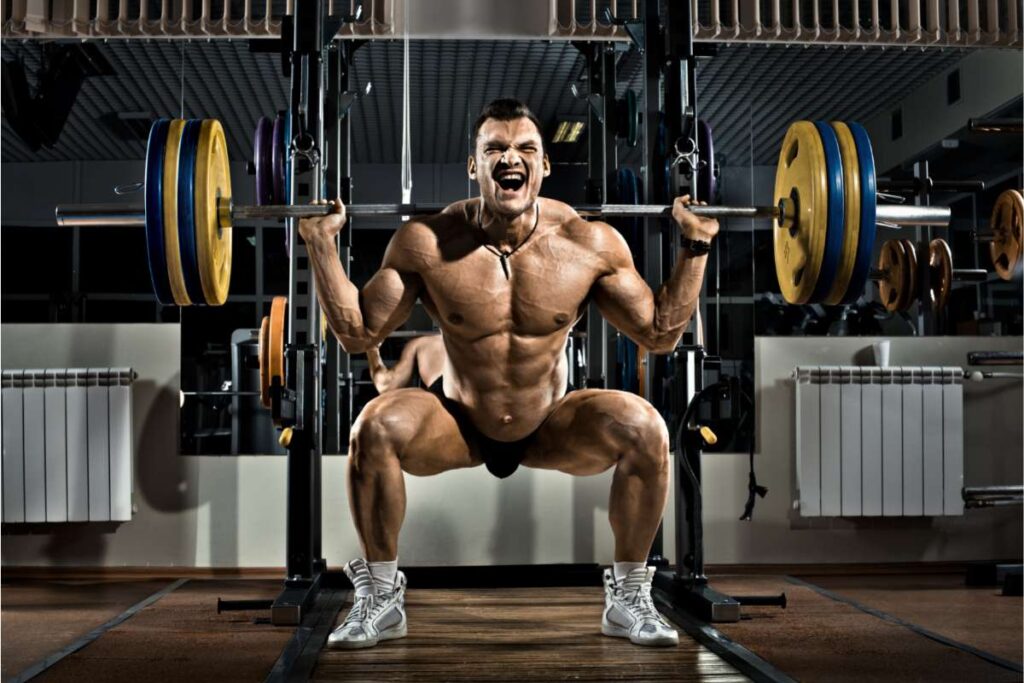
When building bigger legs, knowing your leg anatomy can give you a huge advantage. It will allow you to select the right exercise to complete the job.
Here’s a table presenting the muscle of the legs, including their functions and exercises that target them.
| Muscles | Action | Exercise |
| Quadriceps | Extends the knees | Squat, Lunges, Leg Press, Hack Squat |
| Hamstrings | Flexes the knees | RDLs, Hamstring Curls |
| Glutes | Extends the hips, Stabilizes | Hip Thrusts, Squats, |
| Adductors | Adduct the Legs, Stabilizes | Side Lunges, Sumo Squats, Lunges |
Why are my legs so skinny?
Related: Tired Of Skinny Legs With Big Belly?
One reason for skinny legs is genetics. However, many other factors including exercise, nutrition, and protein intake play a role in your leg size.
Can I get bigger legs?
Related: 15 Best Leg Workouts With Dumbbells
Yes, you can get bigger legs. This can be done by performing hypertrophy exercises in the gym, eating a calorie surplus, and increasing your protein intake.
Things to Consider When Training Your Legs
Related: 5 Must-Try Leg Press Exercises To Target And Tone Your Glutes

Before you start squatting and buying protein powder, keep this information in mind.
Training Goals
When training your legs, identify your training goals.
Whether you are training for strength, mass, or endurance, each style of training has a slightly different approach.
For strength, you will be performing sets of one to five repetitions at 80%-100% of your one repetition maximum (1RM).
If you want to increase muscle mass, complete sets of eight to 12 repetitions at 60%-80%.
For endurance, use sets of 15+ repetitions 60% or less of 1RM.
Type of Training Splits
Your weekly training split can determine how you train your legs.
For beginners, you may target the legs in your single training program.
This is where you hit each muscle group in one training session with each session.
However, if you want to increase the sheer number of leg exercises you perform during the week, consider splitting your training up into movements of body parts.
This may be in the form of push, pull, and leg splits.
You could also stick to an upper body and lower body split, or even a bro split.
When you split your workouts into movements, muscles, or sections of the body, it means you can dedicate more exercises and time to each muscle group.
In this case, the legs.
Volume
Increasing your leg training volume is one of the best ways to increase leg muscle size.
Research has identified that increasing the volume of training for any given muscle group will enhance muscle hypertrophy.
This can be done by performing a split program with dedicated leg training days, even training legs multiple times per week.
If you’re serious about making those pins grow, it is something you should consider.
Genetics
This is key among the many factors that determine our ability to train our legs. While all hope is not lost because we are genetically skinny, it can be more difficult to pack on muscle.
Ectomorphs are skinny built that struggle to increase muscle mass.
Endomorphs present with an athletic build that increases muscle mass.
Mesomorphs appear bigger throughout their entire frame, appearing to have larger limbs without needing to train to appear bigger. However, they’re more susceptible to weight gain.
Schedule
Your schedule plays a huge role in how you train your legs.
After all, if you can’t get to the gym that often, you may find it more difficult to grow your legs.
Leg training takes a great deal of dedication, not only to training, but to recovery.
If you can guarantee yourself you will be able to at least train them once per week you are on the right track.
And if you can manage an additional session, you can truly make some real gains.
If you were doing a bro split, you could program two leg days.
This is in the format of, legs, back, chest, and legs.
This gives you two days in between to recover, and a further three days over the weekend for recovery.
How to Get Big Legs
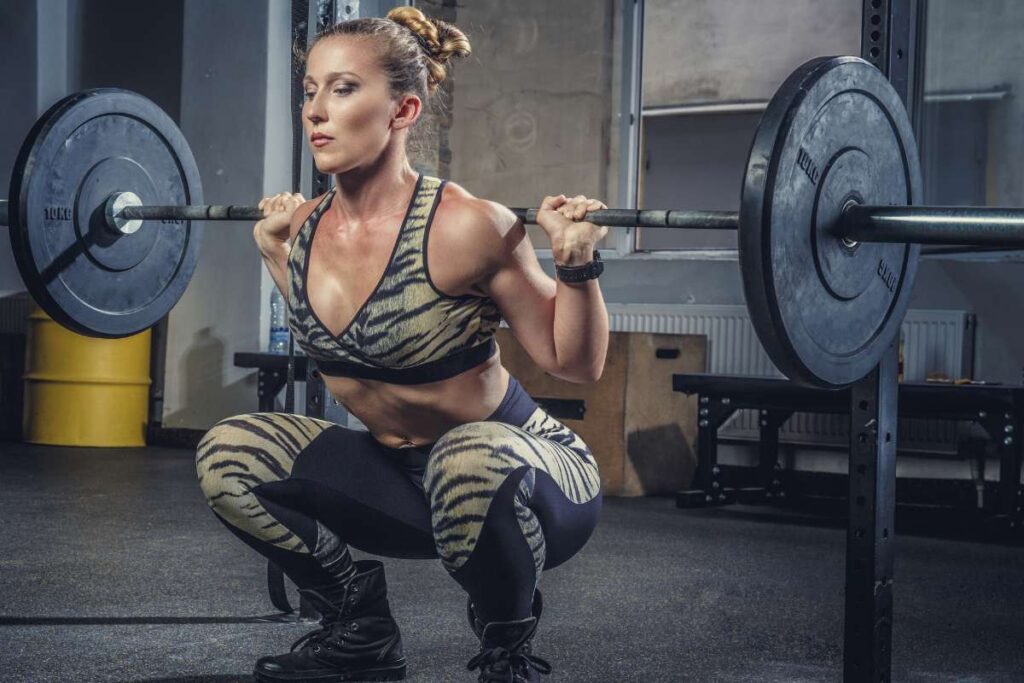
Here’s a list of ways to help you get bigger legs.
Increase Calorie Intake
Growing big legs requires a greater calorie intake, especially if you’re on the skinnier side and have trouble putting on weight.
Research suggests that a calorie surplus of 15% is required to increase muscle mass.
The recommended daily intake is 2,500 calories for men and 2,000 calories for women.
If you are serious about building bigger legs, I recommend making a jump straight to 3,000 cal for men and 2,500 cal for women.
This may seem like a big jump, but doing so with a meal plan that spreads your meals throughout the day is achievable.
Increase Protein Intake
Related: 25 Protein Boosters To Increase Your Protein
Protein intake is one of the most important factors in muscle growth and recovery.
For muscle growth, research suggests 1.6-2.2g of protein per kilogram of body weight.
This may seem like a lot, but big legs and intense training sessions require plenty of fuel to build and recover.
This can be done through the use of eating protein-rich food, including:
- Chicken breast
- Tuna
- Red meat
- Nuts
- Beans
- Oats
- Seeds
This, combined with protein supplements such as shakes or bars, will help you hit those targets.
Increase Leg Training Volume
To maximize leg growth, we need to increase stimulus on our leg muscles.
One of the best ways to do this is by increasing training volume, performing two sessions per week.
You could even aim for three, provided there is enough rest between sessions.
Studies identify that increasing training volume enhances muscle hypertrophy.
That’s why I recommend split programming, scheduling leg sessions a day or two apart for adequate recovery.
Progressive Overload
Progressively overloading your muscles is the key to the growth of your legs.
This refers to gradually increasing resistance or repetitions with each set, or working out to challenge, break down, and rebuild muscle stronger.
To do this, track and record your exercises and the weight you are moving for every set.
Increasing your resistance in small increments can help you continuously make steady gains and continue to stimulate muscle growth.
Target Legs From All Angles
Legs are made up of the glutes, calves, adductors, hamstrings, and quadriceps.
They’re some of the thickest muscles in the body, and for good reason. They’re responsible for supporting our body’s weight and movement.
A mistake many people make when training legs is that they don’t train on all different planes of movement.
By targeting all training your legs through all different planes, you will not only increase the mass of your legs but improve your function.
This can be done with side lunges, curtsy lunges, clams, and a variety of other exercises to hit the legs from all different angles.
Train For Hypertrophy
If you want to build big legs, you need to train for muscle hypertrophy.
To do this, sets of eight to 12 repetitions at 60%-80% of 1RM are recommended to increase muscle mass.
For beginners, one to three sets should be performed, and three to six sets for advanced lifters.
Track Your Macros
Tracking your macros is one of the most effective ways to increase muscle mass and improve your physical appearance.
Research recommends the following macros for increasing mass.
| Macronutrient | Percentage |
| Carbohydrate | 55%-60% |
| Protein | 25%-30% |
| Fats | 15%-20% |
It not only ensures that we are hitting our protein targets but improves our relationship and understanding of the food we are consuming.
And look, I know what you’re thinking – how does being more strict improve my freedom?
By tracking your calories and macros, you can adjust your intake to fit in cheat meals guilt-free.
This will help you stick to your goals for longer.
While tracking your macros isn’t always necessary, it does help you tighten up your nutrition and decrease bad habits.
Plus, it can help you narrow down what it is that’s stunting your leg growth.
The more areas of your nutrition you get in order, the greater your chances of building big legs.
Use Supplements
Using a protein supplement is a great way to give yourself the added protein boost for your recovery and building muscle.
One of the more difficult things new lifters struggle with when wanting to put on muscle is their new calorie and protein targets.
The idea of loading up can be difficult especially if they have always practiced a caloric deficit.
Protein supplements in the form of bars and shakes are a great way to hit your protein and calorie targets.
Shakes make great snacks, and consuming calories in the form of a liquid can give your gut a break from breaking down bigger solids.
How to Get Big Legs at Home
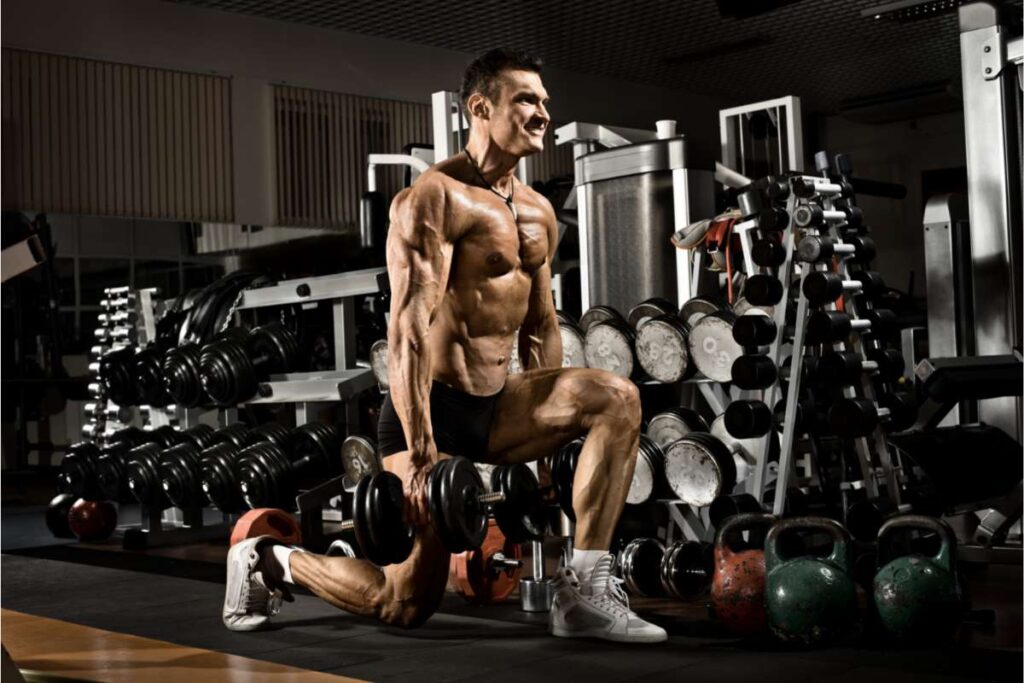
Training legs at home can be a difficult task for many as home gyms don’t have the type or variety of equipment to create the same stimulus.
And while this isn’t always the case, it’s definitely the norm.
Here’s how to get bigger legs at home for both females and males.
How to get bigger legs at home for females?
For females, training legs at home can be done using bands, free weights, and body weights.
As there may be less overall resistance in terms of equipment, consider performing additional sets, increasing reps, and decreasing rest times.
Combine this with movements such as pulse squats, wall sits, isometric holds, and plyometric jumps.
By doing this, you will be able to push your legs, even in the absence of heavier weight.
How to get bigger legs at home for males?
For men, getting bigger legs at home the approach is largely the same.
To create a stimulus big enough to promote muscle growth you will need to use a variety of different types of exercise to exhaust your muscles.
A good way to do this is to base your workout on free-weight exercises such as lunges, squats, and Romanian deadlifts.
Then, couple these exercises with either bodyweight squats or lunges to increase volume.
If you want to add another layer, mix things up with some plyometrics, such as jump squats and jump lunges.
One of the biggest tests for training legs at home is your creativity. When we train at the gym, everything is laid out for us.
However, at home, we need to mix and match a few different styles to get the stimulus our muscles need.
The Best Exercises to Get Bigger Legs
Let’s get down to it. Here’s a list of the best exercises to get bigger legs.
Back Squat
Related: How Much Should I Be Able To Squat?
The back squat is considered to be the best exercise for developing the size and strength of the legs.
By using a barbell on your back, you can increase the load and create the stimulus required to develop huge legs.
Equipment Required
- Barbell
- Weight Plates
- Squat Rack
How To Perform Back Squat
- Step under the barbell and position the bar across your traps, just above your shoulder blades.
- Grab the barbell with both hands.
- Push up to take the weight of the barbell and step back clear of the rack.
- Begin by leading back with your hips and lowering yourself down.
- Lower until hips are parallel with the floor.
- Once at the bottom push yourself back up to the start position. Repeat.
Benefits
- Increase mass
- Improves strength
Pro Tips
- Beginners should start with a lighter weight and focus on technique and contracting the quads and glutes.
- Focus on breathing, inhaling before lowering and exhaling as you push back up.
Front Squat
The front squat is a great exercise for increasing the mass through the legs and hips. The front racked position engages the upper body and decreases spinal load.
Equipment Required
- Barbell
- Weight Plates
- Squat Rack
How To Perform Front Squat
- Step up to the barbell and position it on your collarbone.
- With your arms parallel to the floor, cross your arms, resting them on opposite shoulders.
- Push up with your legs to unrack the bar.
- Take a step back to form the rack.
- Start by leading back your hips and lowering yourself until your knees are bent at 90 degrees.
- Once you reach the bottom push yourself back up to the starting position. Repeat.
Benefits
- Increase mass
- Decreased spinal compression
Pro Tips
- Beginners should start with a dowel rod or just the bar and focus on getting comfortable with bar positioning.
- Keep elbows up at all times to stop the bar from rolling forward off the shoulders.
Reverse Hack Squat
The reverse hack squat offers the ability to load up the quads, glutes, and hamstrings, with the safety of the hack squat’s safety lockout system.
Equipment Required
- Hack Squat
- Weight Plates
How To Perform Reverse Hack Squat
- Step onto the hack squat facing the carriage.
- Place shoulders under shoulder pads.
- Adjust feet so they are midway up the platform and shoulder width apart.
- Push up with legs to take the weight of the carriage and remove the safety lock.
- Begin by leading back with your hips and squatting down to the platform.
- Lower until hips are bent at 90 degrees, then push back up until legs are straight. Repeat.
Benefits
- Increase mass
- Safety locking mechanism
Pro Tips
- Gradually lower yourself with each rep and focus on the contraction of each quadricep, as this will help build your mind-muscle connection.
- Focus on your breathing, inhaling before you lower yourself and exhaling as you push yourself back up.
Leg Press
Related: The Ultimate Guide To Leg Press Foot Placement
The leg press is an incredible machine for training legs, as its rail-based system allows you to simply sit down and push some huge weight.
Equipment Required
- Leg Press
- Weight Plates
How To Perform Leg Press
- Sit down on the leg press and place your feet up on the platform.
- Adjust your feet so that they are midway up the platform and shoulder-width apart.
- Push the carriage up and unlock the safety lockers.
- Bend knees and gradually lower the carriage down.
- Lower until knees are bent at 90 degrees, then push back up to the starting position. Repeat.
Benefits
- Increase mass
- Can focus on pushing weight
Pro Tips
- Placing feet in the middle of the platform will allow you to generate the force needed to push the carriage back up.
- Beginners should gradually increase weight and have a hand on the safety lock at all times in case of failure.
Walking Lunges
Walking lunges are the exercise that everyone loves to hate. They offer the ability to train for balance and unilateral strength, making them a must if you want your legs to grow.
Equipment Required
- Dumbbells/Barbell
How To Perform Walking Lunges
- Standing with a dumbbell in each hand.
- Take a step forward with one foot and drop the back legs knee to the floor.
- Lower until the knee is bent at 90 degrees.
- Push up with both legs until the legs are both straight.
- Have the back leg step up to the front leg, and then take a step forward and repeat.
Benefits
- Develops balance
- Increases mass
Pro Tips
- For the perfect lunge, focus on dropping the back knee to the floor.
- If you are struggling with balance, have your feet meet between each repetition. This will help you reset before your next rep.
Side Lunges
Side lunges are a brilliant exercise for targeting the inner and outer fibers of the legs.
They are also great for creating stability through the hips and balance for the lower body.
Equipment Required
- N/A
How To Perform Side Lunges
- Stand with feet just wider than shoulder-width apart.
- Lean toward one side, bend the knee, and lower yourself toward the floor.
- Lower until your knee is bent at 90 degrees while the opposite leg remains straight.
- Push yourself back up with the bent knee back to the starting position.
- Perform on the opposite side. Repeat.
Benefits
- Increase mass
- Works inner and outer thighs
Pro Tips
- Beginners can start using a suspension trainer or near a squat rack to help them lower into position.
- Between each rep, pause at the top of the movement to reset and regain your balance.
Hip Thrusts
The hip thrust, while not specifically a leg exercise, is likely the most important on this list.
The hips and the glutes are some of the strongest in the body. They’re responsible for generating power and force throughout all of our lower body exercises.
By increasing our glute strength and hip function, we have a better foundation to increase leg strength and mass.
Equipment Required
- Barbell
- Weight Plates
- Bench/Step
How To Perform Hip Thrusts
- Sit down on the floor to the side of a bench with the barbell over the top of your hips.
- Bend knees to 90 degrees and place feet firmly on the floor.
- Grasp the barbell just wider than the shoulder width apart.
- Begin by lifting your hips up until they are parallel to the floor.
- From here lower back down to the starting position. Repeat.
Benefits
- Increase mass
- Improves strength
Pro Tips
- Place padding between the barbell and hips for comfort.
- When lifting the barbell, focus on lifting hips rather than pushing with legs. This will help target the glutes.
Romanian Deadlifts
The Romanian deadlift is a great exercise for building the hamstrings and glutes, which will help increase the overall size and appearance of your legs.
Equipment Required
- Barbell
- Weight Plates
How To Perform Romanian Deadlifts
- Stand holding the barbell just wider than hips.
- Engage lats and pull shoulder blades back and down.
- With legs slightly bent, lead back with the hips until you bent forward at 90 degrees.
- Once you reach this position, lift yourself back up to the starting position. Repeat.
Benefits
- Targets hamstrings
- Increase mass
Pro Tips
- When performing the RDL, focus on hamstring contraction rather than just going lower.
- Focus on breathing, inhaling before you lower and exhaling as you lift back up.
Lying Hamstring Curls
The lying hamstring curls are the perfect exercise to target and grow your hamstrings.
By lying face down, you eliminate almost every other variable, allowing you to focus on getting the best hamstring contraction with every rep.
Equipment Required
- Lying Hamstring Curl
How To Perform Lying Hamstring Curls
- Lie face down and hook your legs under the padding.
- Grasp handles, engage your core and glutes, and curl the padding up until your knee is bent at 30 degrees.
- Once at the top, slowly lower back to the starting position. Repeat
Benefits
- Isolate hamstrings
- Increase mass
Pro Tips
- Gradually lower focusing on hamstring contraction throughout the entire repetition.
- Brace core, and glutes to help remain rigid and improve hamstring contraction.
Calf Raises
Calf raises are an essential part of leg training as our lower leg needs to match the mass of our thighs.
These will help you feel stronger at your foundation and allow for great control of your legs.
Equipment Required
- Dumbbells
How To Perform Calf Raises
- Holding dumbbells, lift your heels off the floor until you are almost on your toes.
- Pause for a second and then lower back down to the floor. Repeat.
Benefits
- Increase mass
- Improve definition
Pro Tips
- At the top of each rep pause and squeeze calves.
- Make sure you are pushing with each calf equally for every rep.
Seated Calf Raises
The seated calf raise is one of the best exercises for increasing calf size.
They target the soleus, the largest of the calf muscles. This exercise will give your lower legs some real shape and mass.
Equipment Required
- Seated Calf Raise
- Weight Plates
How To Perform Seated Calf Raises
- Sit on the seated calf raise.
- Place knees under pads and feet on the platform.
- Push up with lifts and remove safety to take the weight.
- Gradually lower the weight until your heels are angled down to the floor.
- Once at the bottom push the weight back up to the starting position. Repeat.
Benefits
- Increase mass
- Targets biggest calf muscle (soleus)
Pro Tips
- At the top of each rep pause and squeeze the calf muscle.
- When lowering, lower to a full stretch.
What foods make your legs bigger?
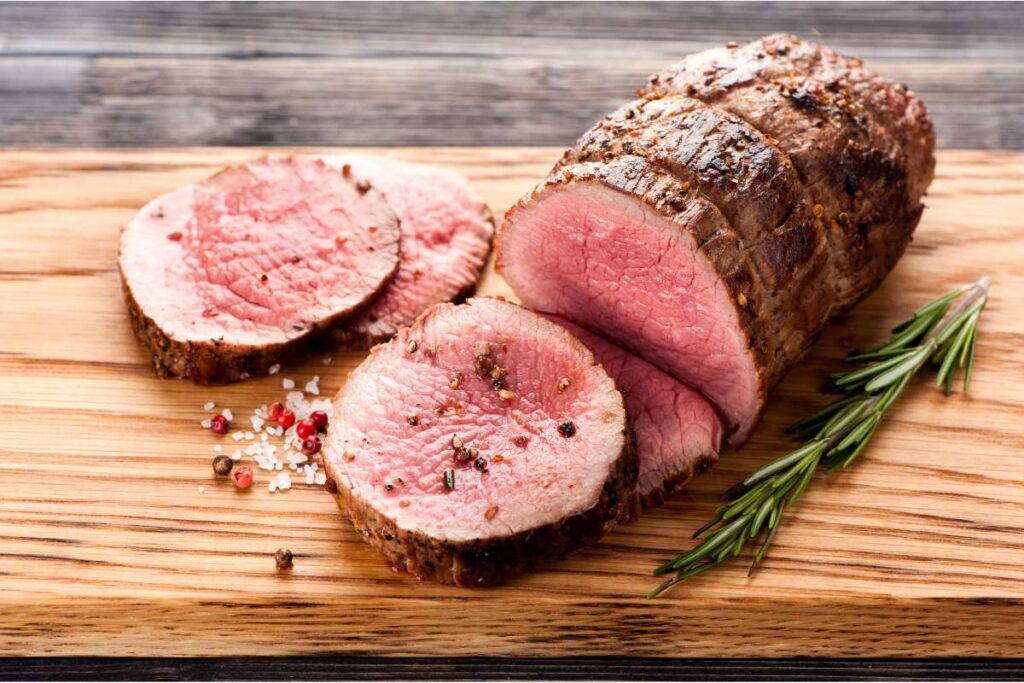
Here is a list of protein-rich foods that you should consider eating to help you build bigger legs.
| Food | Protein (per 100g) | Food | Protein (per 100g) |
| Bean Curd | 50.5 | Beef | 20.3 |
| Broad Bean | 28.2 | Lamb | 17.3 |
| Green Beans | 23.8 | Pork | 16.7 |
| Soy | 36.3 | Pig Skin | 26.4 |
| Oat | 15.6 | Dried Mushroom | 38.0 |
Combining high-protein food with complex carbohydrates such as brown rice, sweet potato, whole grains, and oatmeal will help increase calories and fuel your body.
Looking for a protein supplement but not sure where to start? Check out the 14 Best Protein Powders Without Artificial Sweeteners.
The Best Diet Plan to Get Bigger Legs
Related: 20 Best Foods To Gain Muscle And Boost Your Workouts!
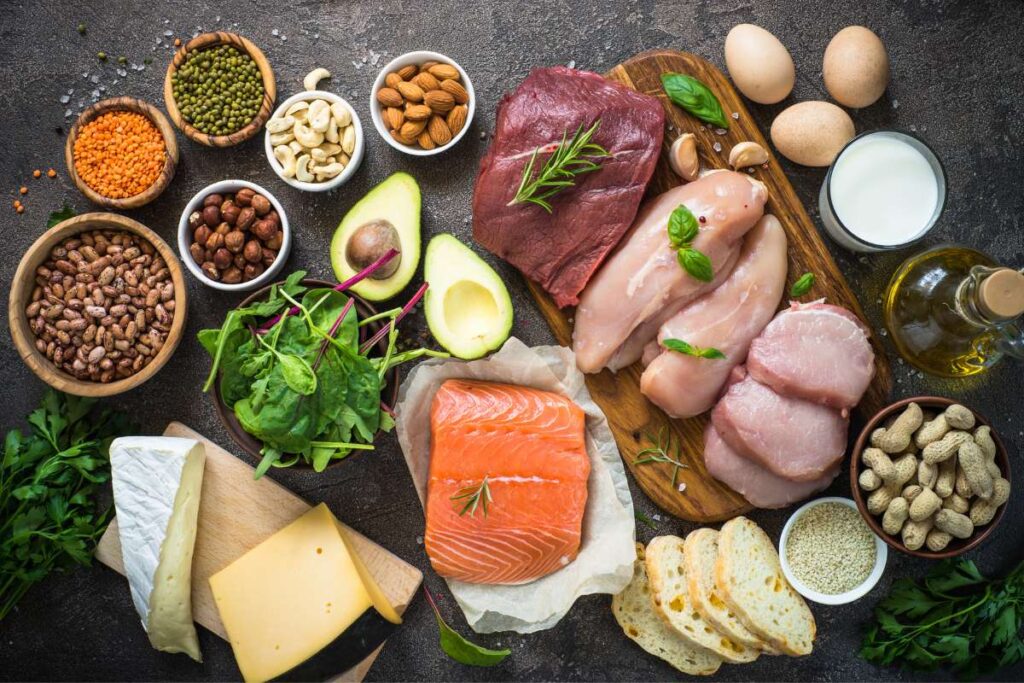
Below is the best diet plan to get bigger legs, which is based on a calorie target of 3,000 cal for men and 2,500 cal for women.
The macronutrient ratio is 55% carbs, 25% protein, and 20% fat.
Hitting your macros will not be exact every time. However, the fact that you are aiming for these numbers will likely put you a long way ahead if you weren’t tracking.
The numbers listed below are a rough guide.
This means that you can reorganize the calories to suit your preferences, providing that you are still hitting your 3,000 cal for men and 2,500 for women.
If you need assistance calculating calories and macros, applications such as MyFitnessPal are great for tracking.
This will help you measure your progress and break down your meals.
Monday
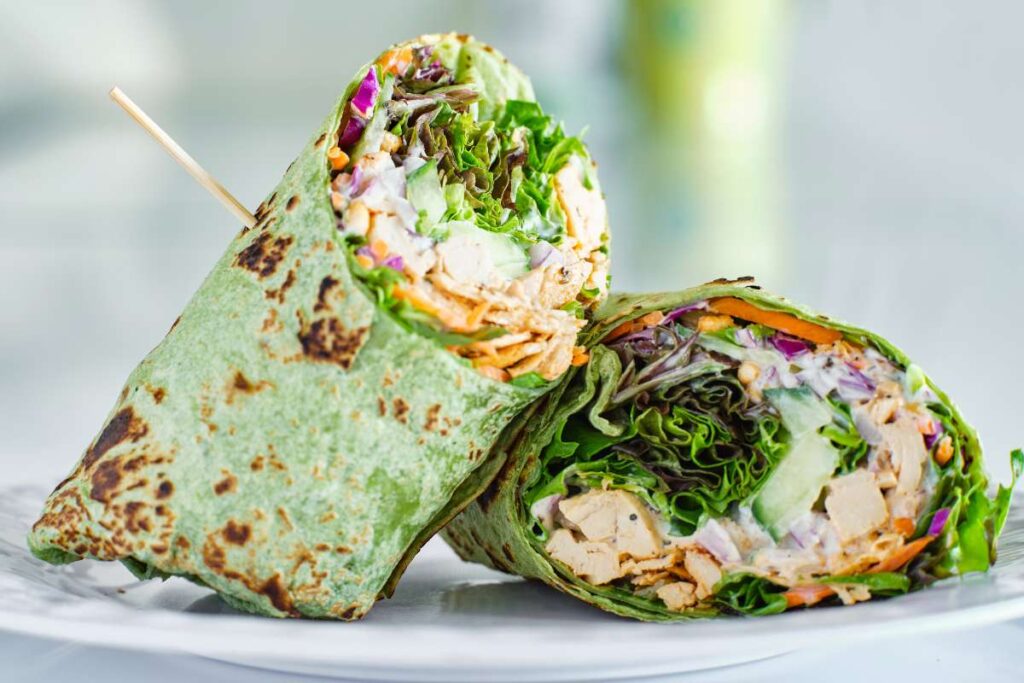
| Meal | Cal (M/F) | Food | Carb (M/F) | Pro (M/F) | Fat (M/F) |
| Meal 1 | 600/500 | Porridge with Berries | 82.6/68.6 | 37.6/31.2 | 13.4/11.2 |
| Snack | 600/500 | Protein Shake w/ Banana, Berries, Yogurt | 82.6/68.6 | 37.6/31.2 | 13.4/11.2 |
| Meal 2 | 600/500 | Chicken Salad Wrap | 82.6/68.6 | 37.6/31.2 | 13.4/11.2 |
| Snack | 600/500 | Nuts, Protein Yogurt, Tuna | 82.6/68.6 | 37.6/31.2 | 13.4/11.2 |
| Meal 3 | 600/500 | Grilled Chicken Stir Fry w/ Brown Rice | 82.6/68.6 | 37.6/31.2 | 13.4/11.2 |
Tuesday
| Meal | Cal (M/F) | Food | Carb (M/F) | Pro (M/F) | Fat (M/F) |
| Meal 1 | 600/500 | Protein Pancakes with Berries | 82.6/68.6 | 37.6/31.2 | 13.4/11.2 |
| Snack | 600/500 | Protein Shake w/ Banana, Berries, Yogurt | 82.6/68.6 | 37.6/31.2 | 13.4/11.2 |
| Meal 2 | 600/500 | Chicken, vegetables w/ brown rice | 82.6/68.6 | 37.6/31.2 | 13.4/11.2 |
| Snack | 600/500 | Nuts, Protein Bar, Tuna | 82.6/68.6 | 37.6/31.2 | 13.4/11.2 |
| Meal 3 | 600/500 | Steak, Steamed Vegetables, and Mashed Sweet Potato | 82.6/68.6 | 37.6/31.2 | 13.4/11.2 |
Wednesday

| Meal | Cal (M/F) | Food | Carb (M/F) | Pro (M/F) | Fat (M/F) |
| Meal 1 | 600/500 | Scrambled Eggs, Shortcut Bacon, Whole Grain Toast | 82.6/68.6 | 37.6/31.2 | 13.4/11.2 |
| Snack | 600/500 | Protein Shake w/ Banana, Berries, Yogurt | 82.6/68.6 | 37.6/31.2 | 13.4/11.2 |
| Meal 2 | 600/500 | Chicken Salad Sandwich, Whole Grain Bread | 82.6/68.6 | 37.6/31.2 | 13.4/11.2 |
| Snack | 600/500 | Nuts, Protein Yogurt, Tuna | 82.6/68.6 | 37.6/31.2 | 13.4/11.2 |
| Meal 3 | 600/500 | Salmon, Steamed Vegetables | 82.6/68.6 | 37.6/31.2 | 13.4/11.2 |
Thursday
| Meal | Cal (M/F) | Food | Carb (M/F) | Pro (M/F) | Fat (M/F) |
| Meal 1 | 600/500 | Porridge with Berries | 82.6/68.6 | 37.6/31.2 | 13.4/11.2 |
| Snack | 600/500 | Protein Shake w/ Banana, Berries, Yogurt | 82.6/68.6 | 37.6/31.2 | 13.4/11.2 |
| Meal 2 | 600/500 | Lean Beef Salad Wrap | 82.6/68.6 | 37.6/31.2 | 13.4/11.2 |
| Snack | 600/500 | Nuts, Protein Yogurt, Tuna | 82.6/68.6 | 37.6/31.2 | 13.4/11.2 |
| Meal 3 | 600/500 | Roast Beef, Roasted Vegetables w/ Brown Rice | 82.6/68.6 | 37.6/31.2 | 13.4/11.2 |
Friday
| Meal | Cal (M/F) | Food | Carb (M/F) | Pro (M/F) | Fat (M/F) |
| Meal 1 | 600/500 | Porridge with Berries | 82.6/68.6 | 37.6/31.2 | 13.4/11.2 |
| Snack | 600/500 | Protein Shake w/ Banana, Berries, Yogurt | 82.6/68.6 | 37.6/31.2 | 13.4/11.2 |
| Meal 2 | 600/500 | Roast Beef Sandwich, Whole Grain Bread | 82.6/68.6 | 37.6/31.2 | 13.4/11.2 |
| Snack | 600/500 | Nuts, Protein Yogurt, Tuna | 82.6/68.6 | 37.6/31.2 | 13.4/11.2 |
| Meal 3 | 600/500 | Grilled Chicken Stir Fry w/ Brown Rice | 82.6/68.6 | 37.6/31.2 | 13.4/11.2 |
Saturday

| Meal | Cal (M/F) | Food | Carb (M/F) | Pro (M/F) | Fat (M/F) |
| Meal 1 | 600/500 | Protein Pancakes with Berries | 82.6/68.6 | 37.6/31.2 | 13.4/11.2 |
| Snack | 600/500 | Protein Shake w/ Banana, Berries, Yogurt | 82.6/68.6 | 37.6/31.2 | 13.4/11.2 |
| Meal 2 | 600/500 | Chicken Salad Wrap | 82.6/68.6 | 37.6/31.2 | 13.4/11.2 |
| Snack | 600/500 | Nuts, Protein Yogurt, Tuna | 82.6/68.6 | 37.6/31.2 | 13.4/11.2 |
| Meal 3 | 600/500 | Steak, Stir Fried Vegetables, and Sweet Potato w/ Brown Rice | 82.6/68.6 | 37.6/31.2 | 13.4/11.2 |
Sunday
| Meal | Cal (M/F) | Food | Carb (M/F) | Pro (M/F) | Fat (M/F) |
| Meal 1 | 600/500 | French Toast with Berries, Yogurt | 82.6/68.6 | 37.6/31.2 | 13.4/11.2 |
| Snack | 600/500 | Protein Shake w/ Banana, Berries, Yogurt | 82.6/68.6 | 37.6/31.2 | 13.4/11.2 |
| Meal 2 | 600/500 | Chicken Salad Wrap | 82.6/68.6 | 37.6/31.2 | 13.4/11.2 |
| Snack | 600/500 | Nuts, Protein Yogurt, Tuna | 82.6/68.6 | 37.6/31.2 | 13.4/11.2 |
| Meal 3 | 600/500 | Grilled Chicken Stir Fry w/ Brown Rice | 82.6/68.6 | 37.6/31.2 | 13.4/11.2 |
Need help increasing those calories? Check out A Healthy 3000-Calorie Meal Plan with PDF
Pro Tips for Getting Bigger Legs
To wrap things up, here’s a list of pro tips for getting bigger legs.
Track Progress
Tracking your progress is one of the most effective ways to ensure you are progressing and sticking to your goals.
More than just writing down your lifts, tracking allows you to set your goals and see how far you come.
This can be an incredible tool when you are months into your training and those gains are coming steadily.
Tracking your weight, measurements, macros, and lifts will all tell a story that will help push you along on your journey to bigger legs.
Be Patient

Building muscles takes time. No one achieves it overnight.
When training any part of our body, we can get obsessed with results.
And when they don’t happen as soon as we’d hoped, we become discouraged and feel like quitting.
This is where you need to manage your expectations and be patient.
Remember, if this is your first time training for bigger legs, you’re breaking records every day just by showing up and putting in the work.
Continue to do so, enjoy the process, and the results will come.
Focus On Muscle Contractions
When you train, you must focus on how your muscles are contracting.
This may sound crazy to some, but many lifters have gone to the gym for years and gone through the motions without a thought about how their bodies were performing.
When this happens, it can be more about the weight they are pushing rather than the stimulus put on the muscle.
If you want to get the most out of each rep, focus on squeezing your working muscles.
Research suggests that doing this can increase mind-muscle connection and results.
Stay Consistent
When it comes to building bigger stronger muscles, consistency is key.
Small incremental progress over time will yield a far greater result than a short burst.
A great way to stay on track long term is to create training blocks, complete with deload weeks and breaks.
This will ensure that both your mind and your body will be fresh, allowing you to continue your pursuit of bigger legs long-term.
Final Thoughts
Building big legs is one of the hardest things to do in the gym.
The sheer stimulus and overload we need to put on the legs combined with the correct nutrition make it an incredible challenge.
But it is absolutely worth it. Bigger legs can give you a balanced physique as well as improved function in every area.
After all, it’s our legs that carry us through life.
Just be sure to train your legs twice per week, eat a calorie surplus, hit your protein targets, and track your progress. You’ll be on your way to having bigger legs in no time.
So, have you had trouble building your legs in the past?
What is the biggest challenge you’ve faced? Let me know in the comments, and share this with anyone you know who wants to begin training their legs more.
How do you get big legs fast?
The fastest way to get bigger legs is to eat a calorie surplus, consume 1.6g-2.2g of protein per kilogram of body weight, and progressively overload.
Muscle takes time to grow. However, if you are consistent with your training and nutrition the gains will come.
How to get bigger legs for skinny guys?
Nutrition is the biggest key for skinny guys, as their metabolism is so high. Eating a calorie surplus, 1.6g-2.2g of protein per kilogram of body weight, and training legs multiple times per week is the key to getting bigger legs.
Consuming enough calories throughout training and daily life with enough left over to increase mass is the biggest challenge.
How long does it take to get big legs?
It can take months and even years to get big legs. However, this is something everyone with big legs has had to go through to get their change.
And while we all progress differently, no one with big legs has done it overnight.
Can legs be made bigger?
Yes, legs can be made bigger through a calorie surplus and resistance training.
How to get thicker legs without exercising?
You can get bigger legs by eating a calorie surplus. However, if you are of a skinnier build, you may run the risk of simply putting on weight through the torso, giving you a skinny-fat appearance.

